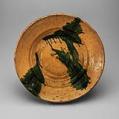Collection: Mariner Southern Ceramics Gallery: Expression

Jar
Elisha Parr
Baltimore, Maryland
1820-1830
Salt-glazed stoneware
HOA: 15 3/8″; WOA: 13 1/2″
The William C. and Susan S. Mariner Collection (5813.6)
The earliest clay objects, produced nearly 30,000 years ago in Eastern Europe, were human and animal figures. Ever since that time, potters have used clay to express their aesthetic impulses. The array of imaginative expression found on Southern pottery is part of this continuum and reflects both time and place. Most ceramic decoration is neither pictorial nor narrative. Undistinguished squiggles, splatters, and splotches can be seen on many examples of Southern pottery. Sometimes, however, the simplest abstract use of color and glaze, combined with the serendipity of the firing process, can result in a visual masterpiece. This seemingly humble earthenware dish made by North Carolina potter Henry Watkins is one such magical combination of color and pattern and could be at home in any art museum in the world.
The depiction of ships can be found on a variety of ceramic mediums, from London delft to Liverpool porcelain. American naval and merchant vessels were a ready-made subject for American stoneware potters. The highly detailed nineteenth-century gunship shown on this large Baltimore jar attests to the skills of the decorator. The aesthetic value of this piece is further suggested by its preservation and care, even though it slumped during the firing of the stoneware kiln.
Other decorators drew on history, politics, nature, and personal experiences for artistic inspiration. Among the many striking and poignant images found on fired clay walls in the gallery, the incised image of a proud gamecock on this Stephen Sweeny storage jar is a near-iconic statement about nineteenth-century Southern agrarian-based culture.



